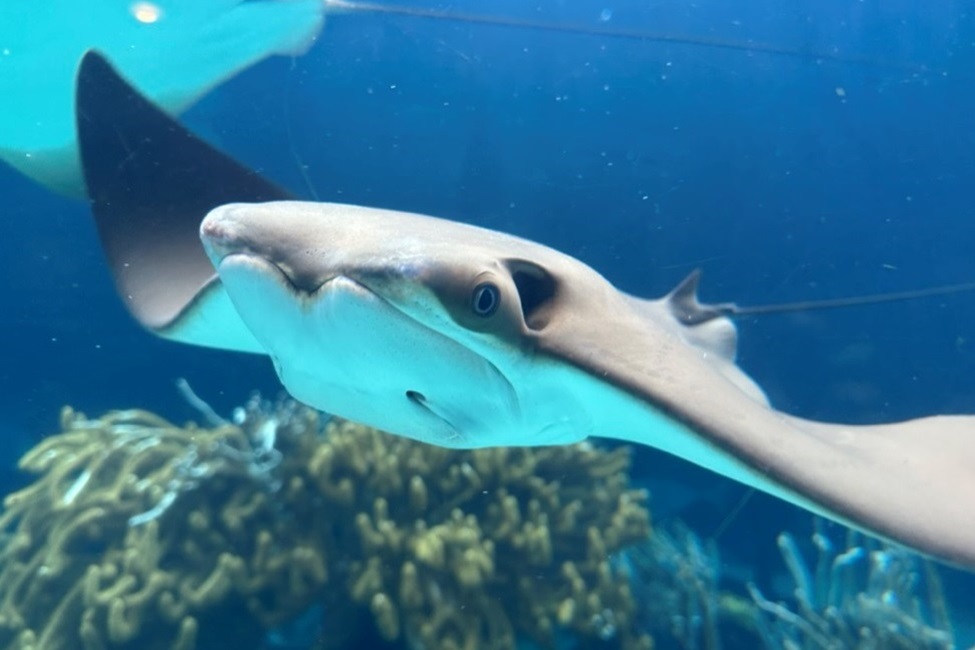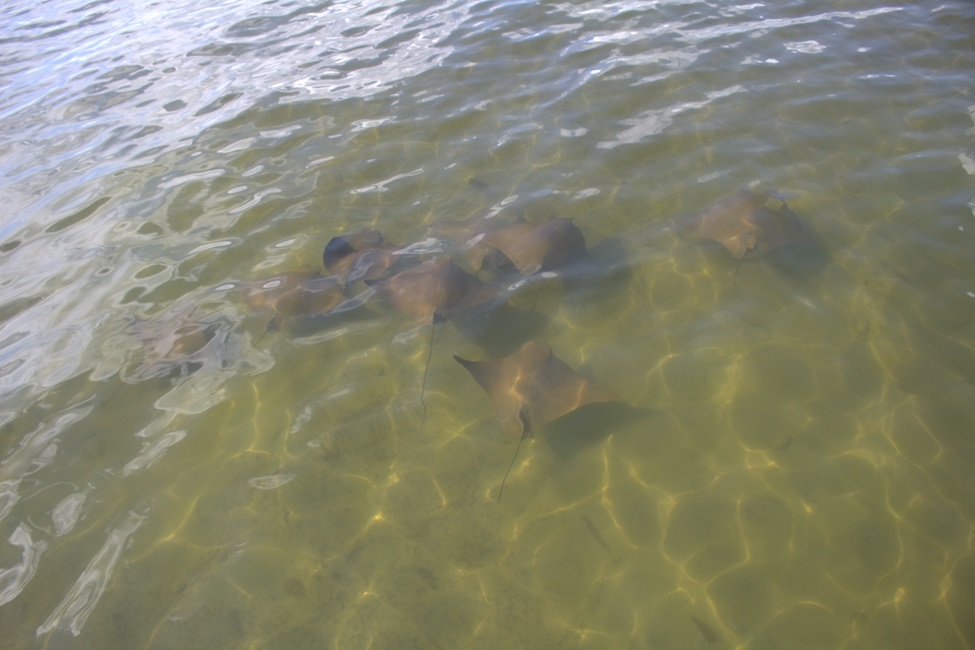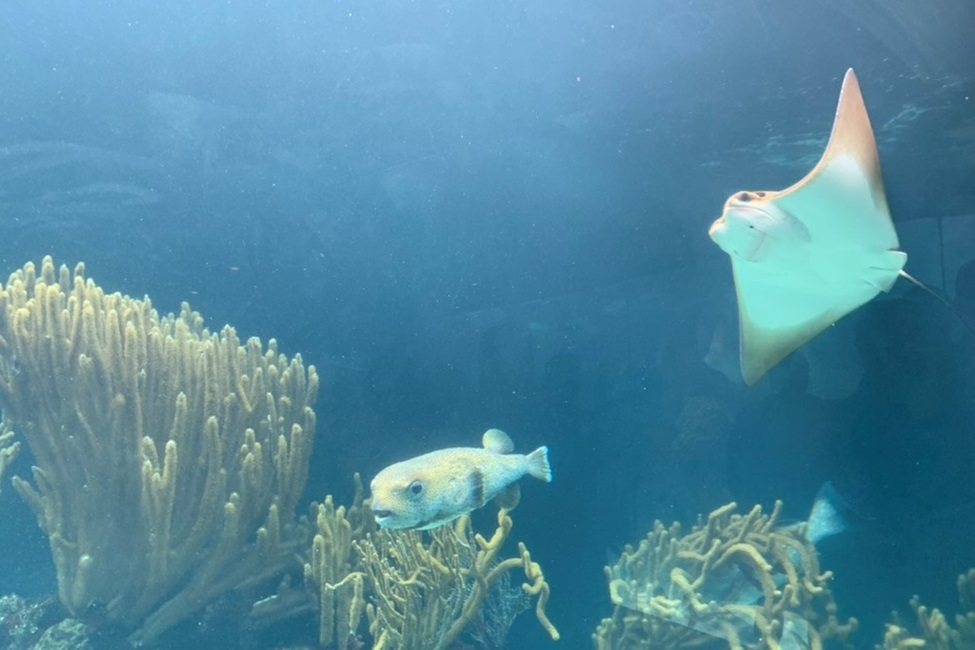After Hundreds of Years, Study Confirms Bermuda Home to Cownose Rays

An Atlantic cownose ray (Rhinoptera bonasus).
For hundreds of years, the whitespotted eagle ray (Aetobatus narinari) has been considered the only inshore stingray species in Bermuda, until now.
Using citizen science, photographs, on-water observations and the combination of morphological and genetic data, researchers from Florida Atlantic University’s Harbor Branch Oceanographic Institute and collaborators are the first to provide evidence that the Atlantic cownose ray (Rhinoptera bonasus) has recently made a new home in Bermuda.
Because cownose rays (Family Rhinopteridae) are highly migratory and prefer tropical and temperate seas, they are typically restricted to continental shelves. Bermuda, located in the northwest region of the Sargasso Sea, is separated from the continental mainland United States by about 1,000 kilometers.
Results of the study, published in the journal Frontiers in Fish Science, confirm the species as R. bonasus and show that after hundreds of years of natural history records, this is a novel migration of Atlantic cownose rays to Bermuda, a group of oceanic islands and circular-like coral reefs. Currently, it is unknown whether this species in Bermuda is a full-time resident or a seasonal visitor. Based on the islands’ mild sea temperatures and remoteness, the study suggests that cownose rays will likely reside in Bermuda for extended periods.
“We don’t exactly know how many Atlantic cownose rays are actually present in Bermuda and whether it’s a single group that keeps getting re-sighted in various locations or whether the species is more broadly distributed across inshore sounds and harbors,” said Matt Ajemian, Ph.D., lead author, an associate research professor and director of the Fisheries Ecology and Conservation Lab at FAU Harbor Branch.
For the study, FAU Harbor Branch, in collaboration with The University of Southern Mississippi; the Department of Environment and Natural Resources, St. George, Bermuda; the Natural History Museum; the Bermuda Aquarium, Museum and Zoo; and NOAA Fisheries, compiled recent information on cownose rays from Bermuda using informal, personal communications with fisheries officers and staff; photographs by local citizen-scientists, and recent on-water observations and collections conducted by the researchers. Researchers also extracted DNA from tissue samples of five individual cownose rays between 2021 and 2022.
Outmigration of cownose rays along the Atlantic coast is triggered by various factors such as temperature. Along the Atlantic coast of the U.S., northward migration cues for females and males depend on different factors: sea surface temperature for females and day of year for males.
“Although all of the cownose rays in Bermuda to date are females, we also observed small, immature rays suggesting pupping may have recently occurred here,” said Ajemian. “Moreover, there have been reports of behaviors indicative of copulation, including close following and biting of pectoral fins that suggests male rays are also present in the area.”
The study also offers another probable mechanism that may have facilitated this recent expansion of Atlantic cownose rays to Bermuda – oceanography.
“Atmospheric conditions including wind and extreme weather events such as storms have been shown to trigger abnormal migratory behaviors in other large marine animals such as loggerhead sea turtles,” said Ajemian.
Interestingly, during the time period preceding the expansion of cownose rays to Bermuda (winter 2010), the North Atlantic Ocean experienced a pronounced southward shift in westerly winds that were also unusually strong and influenced current dynamics in the region. This transition facilitated an unprecedented push of floating Sargassum seaweed toward the eastern Atlantic, including Bermuda.
“This climatological anomaly and associated oceanographic changes may have played a similar role in shifting cownose rays eastward from their established range to Bermuda,” said Ajemian. “Extensive tropical storm activity also occurred between Bermuda and the continental U.S. in the years leading up to the first claimed sighting of cownose rays and could have displaced these animals offshore into the Gulf Stream.
Similarly, in 1609, the Sea Venture, a 17th-century English sailing ship encountered a tropical storm and was shipwrecked with her crew and passengers landing on the uninhabited Bermuda.
“Perhaps these Atlantic cownose rays encountered bad weather just like the Sea Venture did and found their new paradise in Bermuda,” said Ajemian. “In the end, we don’t know if it was a single event or a combination of conditions that brought these animals here, but either way it’s an incredible trip!”
Findings from the study suggest that cownose rays have been in Bermuda for more than a decade since 2012 and observations of the species continue to be sustained today.
“If cownose rays continue to survive in Bermuda waters, the species’ low fertility rate of one pup per year will limit its capacity for rapid population growth, which is why we greatly need a more accurate assessment of the current population size.”
Researchers suggest gleaning this information using systematic aerial surveys and monitoring size class to determine the level of reproductive success of the established population. Furthermore, collecting dietary information will help to identify the prey resources that the species is interacting with and whether any of these are shared with the protected whitespotted eagle ray. Fortunately, the two species co-exist in other regions, but space is limited in Bermuda and so the researchers remain cautious of potential competition.
“We need more research into the potential mechanisms that facilitated the arrival of cownose rays to Bermuda, as this could reveal whether additional introductions of this species and others are possible in the future,” said Ajemian.
Study co-authors are Ceclia Hampton, a graduate student at FAU Harbor Branch; Lauren M. Coleman, The University of Southern Mississippi; Joanna M. Pitt, Ph.D., Department of Environment and Natural Resources, Bermuda; Struan R. Smith, Ph.D., Bermuda Natural History Museum; Christian M. Jones, Ph.D., NOAA Fisheries; and Nicole M. Phillips, Ph.D., The University of Southern Mississippi.


-FAU-
Latest News Desk
- FAU Foundation Board Welcomes New MembersFlorida Atlantic University's Foundation Board of Directors welcomed Zachary "Zach" Berg '97, '00, Michael Yoon '96 and Thomas "Tommy" Zeichman '09 to its board.
- FAU Researcher to Make Big 'Splash' in NatGeo's SharkFestShark fanatics, science buffs and ocean advocates won't want to miss a thrilling new episode of NatGeo's "Florida's Bite Capital," with FAU professor Stephen Kajiura, Ph.D. on National Geographic.
- FAU's Paulina DeVito Awarded Elite NSF Graduate Research FellowshipPaulina DeVito, 22, a Ph.D. candidate in FAU's College of Engineering and Computer Science, has been awarded a prestigious National Science Foundation fellowship for her exemplary work in AI and education.
- Hope for Brain Cancer: FAU Awarded Grants for Glioblastoma TreatmentFAU researchers are pioneering a new approach to treating glioblastoma - a highly aggressive brain cancer with one of the highest mortality rates - by targeting the gene MBLAC1 for the first time.
- John Kelly, Ph.D., Announces Retirement from FAUAfter over a decade of dedicated service, John Kelly, Ph.D., announced his retirement from FAU. Having served as FAU's president during a transformational eight-year tenure, his last day will be June 30.
- Chef José Andrés' Longer Tables Fund Will Expand FAU Queen Conch LabThe grant awarded to FAU Harbor Branch supports the expansion of its queen conch aquaculture lab and is part of a global philanthropic effort to tackle urgent challenges through the power of food.






